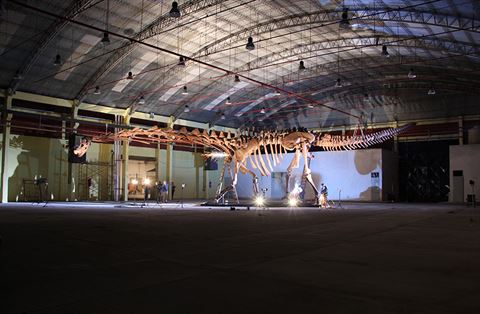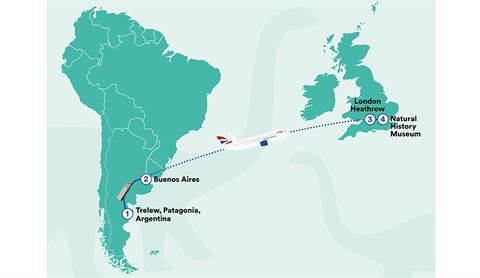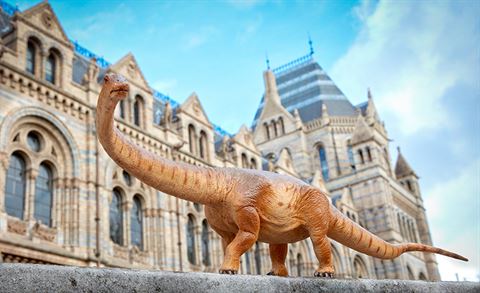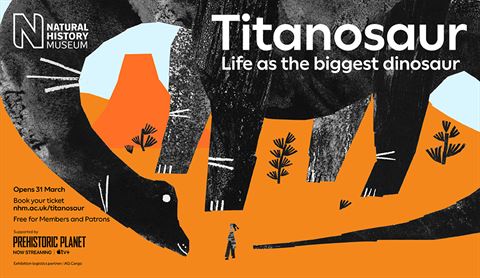THE INSIDE TRACK • March 2023
Titanosaur on tour
Not your average cargo, a 101-million-year-old titanosaur – one of the largest known creatures to have ever walked our planet – has made its way from Buenos Aires to London, courtesy of two of our passenger flights. And it’s not just any old titanosaur either: we moved a Patagotitan mayorum – the big daddy of the group.
The remarkable replica will be unveiled for the first time in Europe at the Natural History Museum’s new temporary exhibition, Titanosaur: Life as the biggest dinosaur, opening on 31 March 2023 in London. Agatha Zarzycki reveals why it doesn’t get more colossal than this…
What is a titanosaur?
Titanosaurs, a group of sauropods – herbivorous dinosaurs that had small heads, long necks and long, whip-like tails – lived on every continent during the Cretaceous period. Patagotitan lived 101 million years ago in the forests of today’s Patagonia, where they roamed in herds from one place to the next. So what set titanosaurs apart from their sauropod counterparts? They had wider hips, fewer toe bones on their front limbs, and some even had armour in their skin called osteoderms.
As you might be able to guess from the name, the titanosaurs’ real claim to fame comes from their size. Three times larger than the roaring Tyrannosaurus rex, Patagotitan reached over 120ft in length – comparable to an Airbus A320 – and weighed around 57 tonnes – more than nine African elephants or around four times heavier than Dippy the Diplodocus. It’s hard to believe that their eggs were smaller than a football (that’s a lot of growing to do).
Bringing Patagotitan mayorum to life
Fast-forward to 2010, when a rancher in La Flecha, Argentina, spotted a bone sticking out of the ground. More than 280 bones were eventually excavated and brought to the nearby Museo Paleontológico Egidio Feruglio in Trelew, and a replica was built at the museum’s factory.

Patagotitan skeleton at the Museo Paleontológico Egidio Feruglio (MEF, D. Pol.)
Each fossil – including a femur (thigh bone) measuring more than two metres – was scanned and reconstructed from materials such as latex and polyester resin with fiberglass. The originals are preserved for research and five of these – including the femur – are exhibited near the replica, meaning, yes, you can indeed see them at Titanosaur: Life as the biggest dinosaur. As 100 per cent of a skeleton was never uncovered, the remaining parts were recreated based on similar species. The result? A magnificent model that’s over 120ft long (nearly 40ft longer than Hope the blue whale) and weighs more than 2,700kg.
How does a dinosaur catch a flight?
Plans to move the cast from Trelew to London began in 2022. Taking it apart took four months and a team of 20 experts, who used everything from cranes to drills and brushes – they even had lifting platforms to reach the skull and the last piece of the tail. Then came one week of packaging the 225 bones into 32 specially designed crates, along with four which contained real fossils, engineered to ensure that the parts did not move during transport. The smallest box, containing the skull, measured 1.2m x 60cm and the largest 3.4m x 1.8m (picture a carthorse). All were loaded into two trucks, journeying 1,300km from Trelew to the Ezeiza Airport in Buenos Aires, where they were handed over to our sister company, IAG Cargo.

“It’s a privilege to partner with the Natural History Museum as the custodian of some of the world’s most important scientific artefacts. I want to thank our teams in Argentina and the UK who made this colossal task of transporting a 120ft dinosaur a reality.”
John Cheetham, Chief Commercial Officer at IAG Cargo
Every single bone required a temporary export permit for paleontological heritage, which included its name and code of the collection, weight, size and a photograph (similar to a passport), as well as insurance and a visa-like document, giving it permission to be out of the country for one year – which explains the four days of customs clearance and security checks. Finally, the titanosaur took its seat(s) and to the skies inside the bellies of two British Airways B787-9 aircraft.
Titanosaur touchdowns
After journeying for almost 7,000 miles, Patagotitan mayorum landed at London Heathrow, where it was transferred to a secret off-site storage facility. More inspections followed before the 32 crates were moved to England’s ‘cathedral to nature’, the Natural History Museum.
“We are so grateful that IAG Cargo transported the cast of Patagotitan to the Natural History Museum for its European debut. Our fascination with dinosaurs provides the ideal opportunity to inspire and inform the next generation about the natural world, and empower them to act for the planet”
Dr Alex Burch, Director of Public Programmes, Natural History Museum

A toy titanosaur braces for the real thing (Trustees of the Natural History Museum)
Unloading the boxes – some of which weighed almost 800kg – into a Victorian building with restricted door sizes, terracotta walls and fragile mosaic floors meant tracking down special lifting equipment and meeting many other challenges (all well worth it, of course). It took more than a fortnight, four separate out-of-hours deliveries, up to eight members at any one period from the internal production team and three technicians from the Museo Paleontológico Egidio Feruglio to get it all done, including the very important task of building the titanosaur cast. The dinosaur was assembled from the feet up and put together one piece at a time like a giant toy model (trust us, you’re going to want to see it).
A night at the museum
The Natural History Museum is no stranger to knocking the scientific socks off our feet, and Titanosaur: Life as the biggest dinosaur is proof. Taking place inside the stunning 30ft-high Waterhouse Gallery, the exhibition has been developed by the Museum’s dinosaur experts. Not only will it feature the full replica (which would alone be worth a visit), but the exhibition will also showcase Patagotitan fossils, as well as other dino specimens from the Museum’s world-renowned collections, which impressively hold more than 80 million objects. Alongside interactive games and displays, visitors will get hands on with touchable specimens (including Patagotitan itself!), learning what life was like for the massive reptile, from its adolescence to how it found enough food (around 129kg of plants each day) to survive.
Walk next to one of the biggest creatures to ever roam the Earth. Tickets from £16. Book here.

British Airways is a sister airline of IAG Cargo, the cargo division of International Airlines Group. The partnership between IAG Cargo and the Natural History Museum aims to deliver exhibitions to international cultural institutions, creating more opportunities for people across the globe to share the wonder of the natural world.
After more freight-full tales? Check out what was flying under your feet in 2022 and IAG Cargo Magazine.
